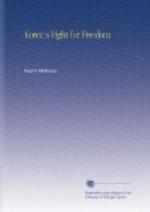Were this an isolated instance, it would scarcely be necessary to mention it. But what I heard on all sides went to show that in a large number of fights in the country the Japanese systematically killed all the wounded and all who surrendered themselves. This was not so in every case, but it certainly was in very many. The fact was confirmed by the Japanese accounts of many fights, where the figures given of Korean casualties were so many killed, with no mention of wounded or prisoners. In place after place also, the Japanese, besides burning houses, shot numbers of men whom they suspected of assisting the rebels. War is war, and one could scarcely complain at the shooting of rebels. Unfortunately much of the killing was indiscriminate, to create terror.
I returned to Seoul. The Japanese authorities evidently decided that it would not be advisable to arrest me for travelling in the interior without a passport. It was their purpose to avoid as far as possible any publicity being given to the doings of the Righteous Army, and to represent them as mere bands of disorderly characters, preying on the population. They succeeded in creating this opinion throughout the world.
But as a matter of fact the movement grew and grew. It was impossible for the Koreans to obtain arms; they fought without arms. In June, 1908, nearly two years afterwards, a high Japanese official, giving evidence at the trial of Mr. Bethell before a specially convened British court at Seoul, said that about 20,000 troops were then engaged in putting down the disturbances, and that about one-half of the country was in a condition of armed resistance. The Koreans continued their fight until 1915, when, according to Japanese official statements, the rebellion was finally suppressed. One can only faintly imagine the hardships these mountaineers and young men of the plains, tiger hunters, and old soldiers, must have undergone. The taunts about Korean “cowardice” and “apathy” were beginning to lose their force.
X
THE LAST DAYS OF THE KOREAN EMPIRE
Prince Ito—he was made Prince after the abdication of Yi Hyeung—was Resident-General of Korea from 1906 to 1908, and was followed by Viscount Sone, who carried on his policies until 1910. Ito is still remembered as the best of the Japanese administrators.
He had an exceedingly difficult task. He had to tear up an ancient administration by the roots, and substitute a new. This could not fail to be a painful process. He had the best and the worst instincts of a nation aroused against him, the patriotism and loyalty of the Korean people, and also their obstinacy and apathy. He was hampered by the poor quality of many of the minor officials who had to carry out his orders and still more by the character of the settlers from his own land. The necessities of Japanese Imperial policy compelled the infliction of much injustice on the Korean people.




